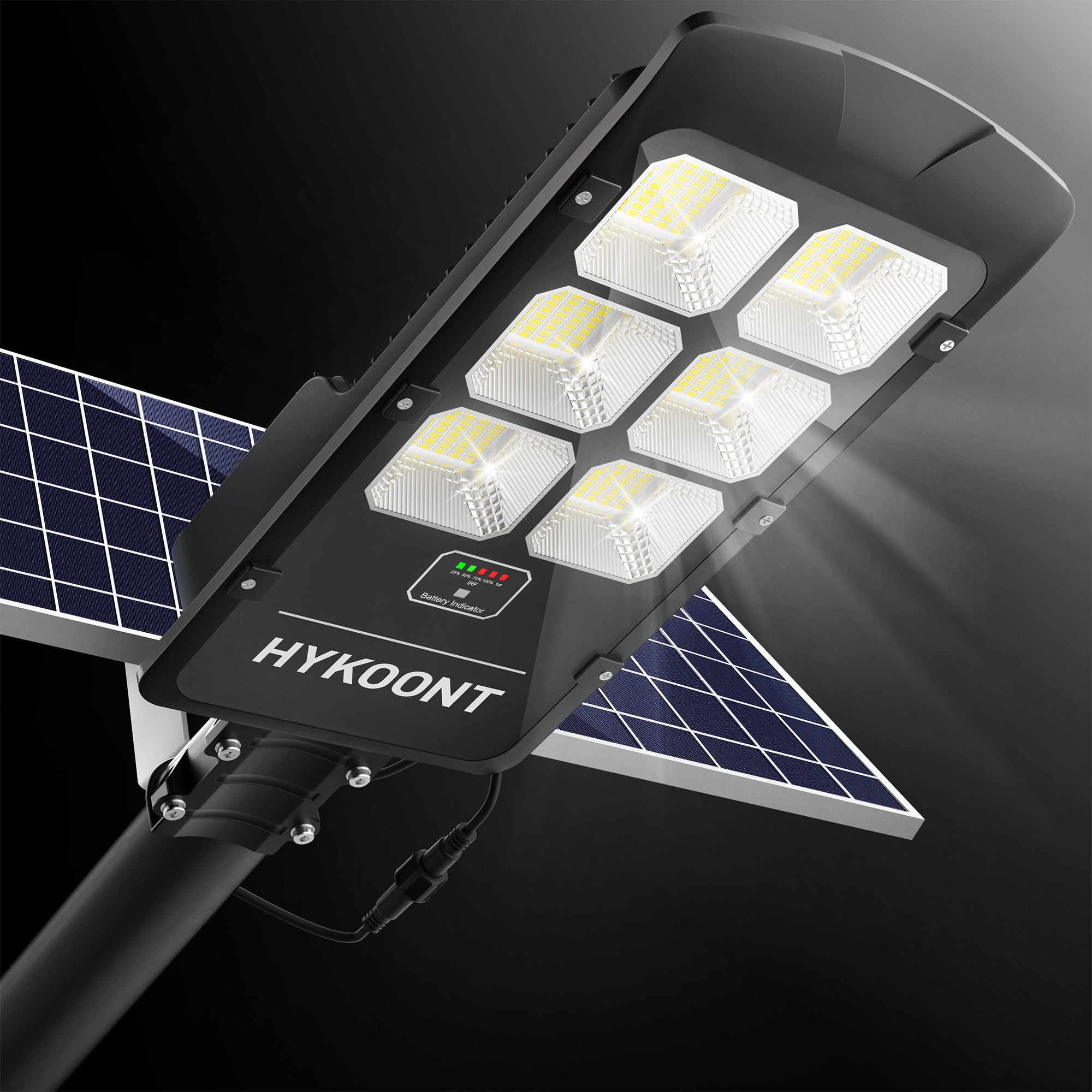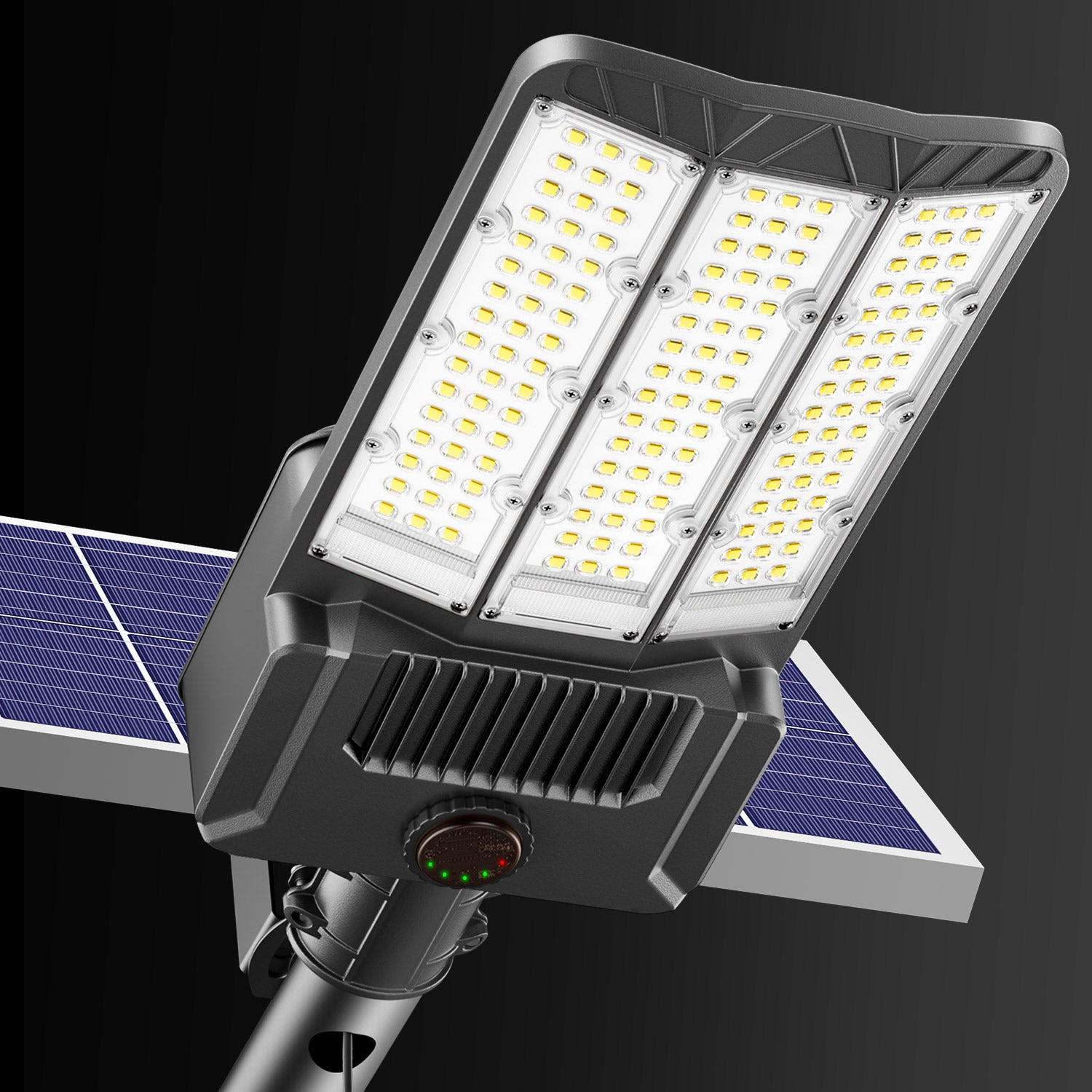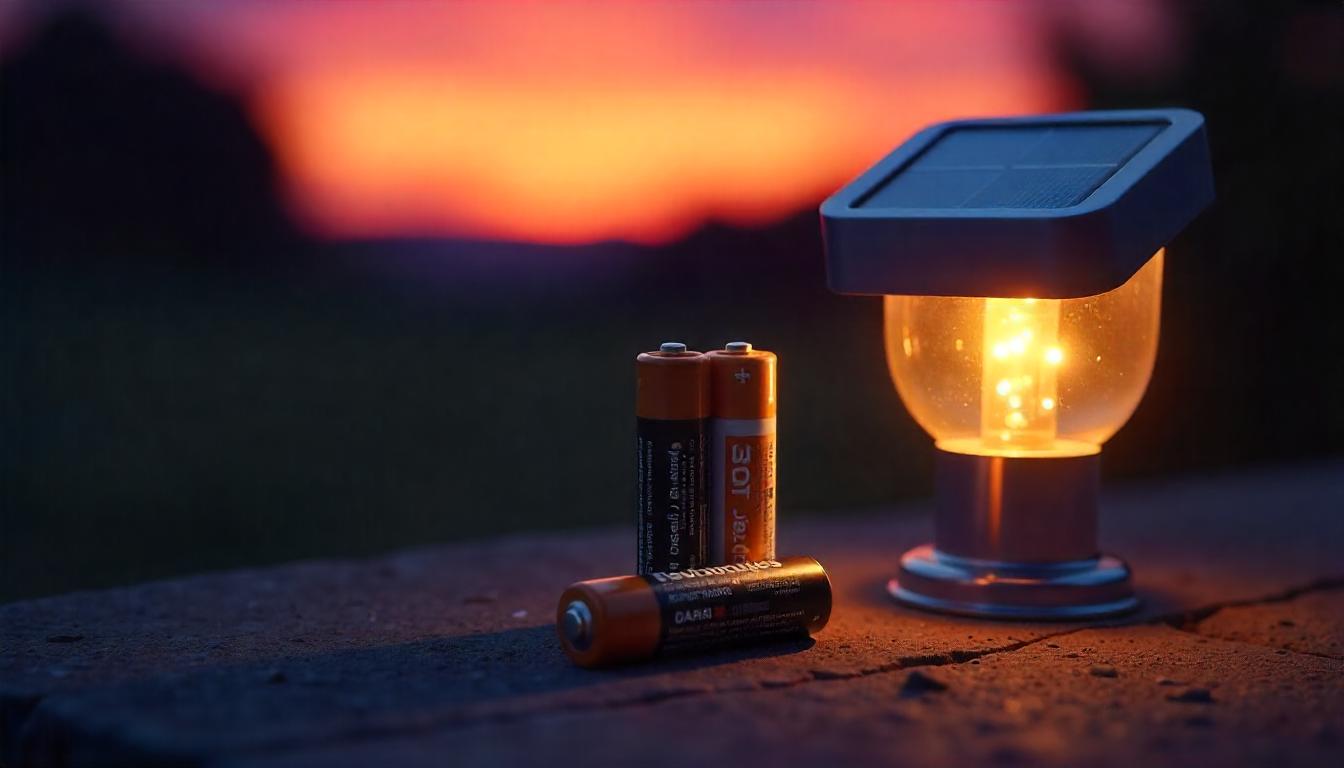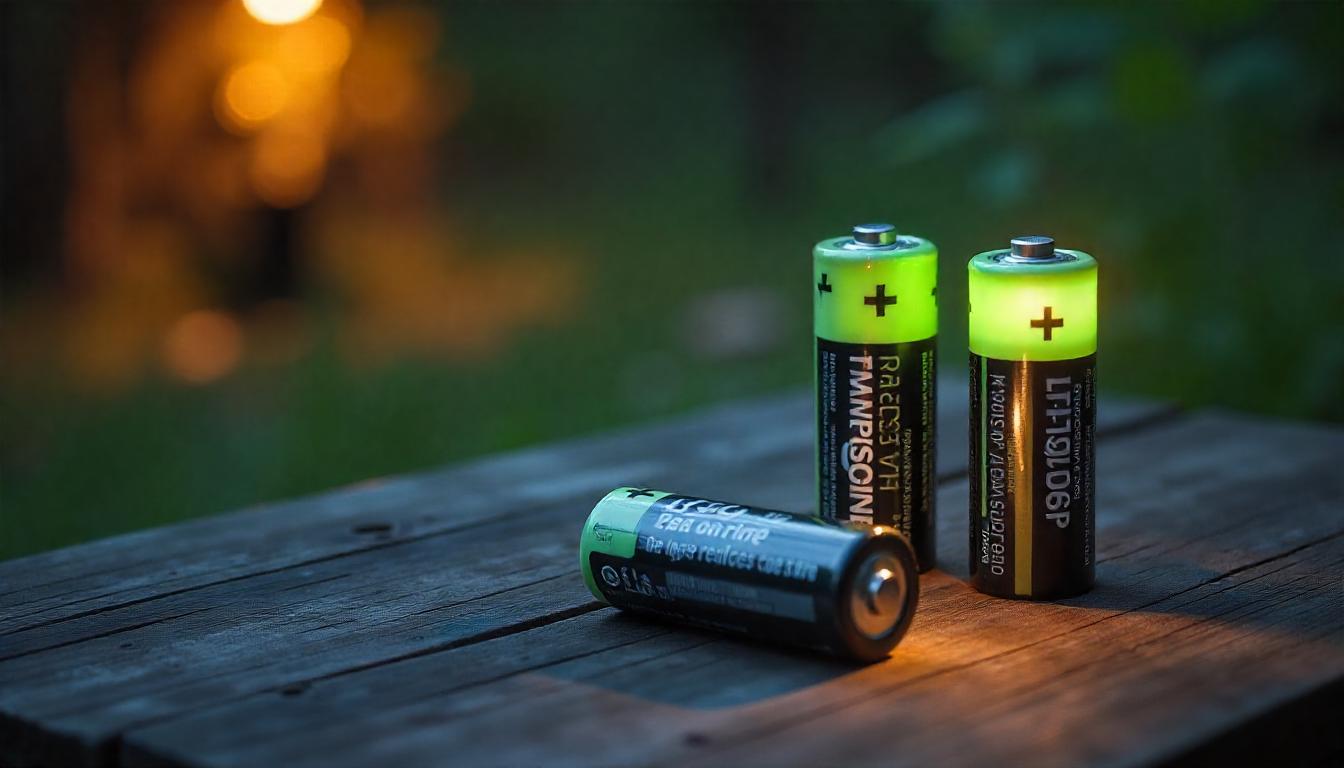كيف تعمل بطاريات AA القابلة لإعادة الشحن في الأضواء الشمسية؟
في الإضاءة الشمسية، تمتص اللوحة الشمسية ضوء الشمس وتحوله إلى طاقة كهربائية يتم تخزينها في البطاريات. وعندما تغرب الشمس، يتم إطلاق الطاقة المخزنة في البطاريات، مما يغذي مصابيح LED في الضوء. ونظرًا لتكرار هذه الدورة يوميًا، فيجب أن تكون البطاريات قادرة على إعادة الشحن عدة مرات خلال عمرها الافتراضي، مما يجعل بطاريات AA القابلة لإعادة الشحن مثالية. تحتاج البطاريات القابلة لإعادة الشحن المستخدمة في الإضاءة الشمسية إلى تحمل دورات شحن وتفريغ متكررة، إلى جانب التعرض لتغيرات درجات الحرارة. وهي مصممة خصيصًا للتعامل مع هذه الظروف، على عكس بطاريات AA التي يمكن التخلص منها والتي لا يمكن إعادة شحنها وتفقد طاقتها بسرعة.أنواع بطاريات AA القابلة لإعادة الشحن للأضواء الشمسية
هناك عدة أنواع رئيسية من بطاريات AA القابلة لإعادة الشحن المستخدمة في الأضواء الشمسية، ولكل منها مزاياها واستخداماتها المثالية:- هيدريد النيكل المعدني (NiMH) :
- المزايا : تعد بطاريات NiMH من بين أكثر البطاريات شيوعًا في الإضاءة الشمسية نظرًا لسعتها العالية وخلوها من المعادن الثقيلة السامة. وهي صديقة للبيئة أكثر من الأنواع الأخرى وتعمل بشكل جيد في ظل الظروف الخارجية النموذجية.
- العيوب : بطاريات NiMH أكثر حساسية لدرجات الحرارة القصوى من بطاريات NiCd. وقد تكون أعمارها أقصر قليلاً في المناخات شديدة الحرارة أو البرودة.
- الأفضل لـ : معظم مصابيح الطاقة الشمسية القياسية، وخاصة تلك التي تتطلب قدرات أعلى لفترات إضاءة أطول.
- المزايا : بطاريات NiCd متينة، وتعمل بشكل جيد في درجات حرارة مختلفة، ومقاومة لتأثير الذاكرة (الفقدان التدريجي للسعة إذا لم يتم تفريغها بالكامل قبل إعادة الشحن).
- العيوب : تحتوي على الكادميوم، وهو معدن ثقيل سام ويمكن أن يشكل خطرًا على البيئة إذا لم يتم التخلص منه بشكل صحيح. كما أنها أقل سعة عادةً مقارنة ببطاريات NiMH.
- الأفضل لـ : الأضواء الشمسية في درجات الحرارة القصوى أو المناطق التي تكون فيها التقلبات في درجات الحرارة شائعة.
- المزايا : تتمتع بطاريات Li-Ion بكثافة طاقة عالية ويمكن أن تدوم لفترة أطول بكثير من بطاريات NiMH وNiCd. وهي خفيفة الوزن ومعروفة بقدرتها على الاحتفاظ بالشحنات بشكل جيد، حتى بعد دورات عديدة.
- العيوب : إنها أكثر تكلفة وقد لا تكون متوافقة مع جميع الأضواء الشمسية بسبب متطلبات الشحن المختلفة الخاصة بها.
- الأفضل لـ : الأضواء الشمسية عالية الطاقة أو أضواء الأمان، حيث تكون أوقات الإضاءة الأطول ضرورية.
- المزايا : بطاريات LiFePO4 أكثر استقرارًا من بطاريات Li-Ion، ولها عمر افتراضي أطول، وهي أكثر أمانًا في درجات الحرارة المرتفعة.
- العيوب : هذه البطاريات هي من بين أغلى البطاريات وقد لا تناسب جميع حجرات بطارية AA بسبب اختلاف الحجم قليلاً.
- الأفضل لـ : الأضواء الشمسية عالية الأداء أو عالية الطاقة التي تتطلب طاقة ثابتة في البيئات القاسية.

مزايا استخدام بطاريات AA القابلة لإعادة الشحن في الأضواء الشمسية
إن استخدام بطاريات AA القابلة لإعادة الشحن للأضواء الشمسية له فوائد عديدة:
- فعّالة من حيث التكلفة : تعمل البطاريات القابلة لإعادة الشحن على تقليل الحاجة إلى الاستبدال المتكرر، مما يوفر المال بمرور الوقت.
- صديقة للبيئة : نظرًا لأنه يمكن إعادة شحنها عدة مرات، فإن هذه البطاريات تنتج نفايات أقل مقارنة بالبطاريات التي يمكن التخلص منها.
- الأداء الأمثل : تم تصميم البطاريات القابلة لإعادة الشحن للتعامل مع دورات الشحن والتفريغ المستمرة، مما يضمن عمل الأضواء الشمسية بشكل موثوق ليلاً بعد ليل.
- عمر افتراضي أطول : مقارنة بالبطاريات التي تستخدم لمرة واحدة، والتي تنفد بعد الاستخدام لمرة واحدة، يمكن للبطاريات القابلة لإعادة الشحن أن تدوم لمدة تصل إلى عدة سنوات في الأضواء الشمسية عند صيانتها بشكل صحيح.
اختيار البطارية القابلة لإعادة الشحن المناسبة لضوء الشمس الخاص بك
عند اختيار بطاريات AA القابلة لإعادة الشحن للأضواء الشمسية، ضع العوامل التالية في الاعتبار:
- السعة (مللي أمبير/ساعة) : يخبرك تصنيف مللي أمبير/ساعة (مللي أمبير/ساعة) بكمية الطاقة التي يمكن للبطارية تخزينها. يعني تصنيف مللي أمبير/ساعة الأعلى أن البطارية يمكنها تخزين المزيد من الطاقة، مما يوفر أوقات إضاءة أطول. بالنسبة للمصابيح الشمسية، عادة ما تكون البطاريات ذات السعات بين 600 مللي أمبير/ساعة و2000 مللي أمبير/ساعة كافية، اعتمادًا على احتياجات الطاقة للضوء.
- عمر البطارية (دورات إعادة الشحن) : تتمتع البطاريات القابلة لإعادة الشحن بعدد محدود من دورات الشحن والتفريغ. على سبيل المثال، يمكن لبطاريات NiMH التعامل غالبًا مع ما يصل إلى 1000 دورة، بينما قد تدوم بطاريات Li-Ion عالية الجودة حتى 2000 دورة.
- أداء درجة الحرارة : إذا تعرضت أضواء الطاقة الشمسية الخاصة بك لدرجات حرارة عالية، ففكر في استخدام بطاريات NiCd أو LiFePO4، والتي تكون مجهزة بشكل أفضل للتعامل مع الظروف القاسية.
- التوافق : تأكد من أن الجهد والحجم متوافقان مع مصباحك الشمسي. تستخدم معظم مصابيح AA الشمسية بطاريات NiMH أو NiCd بقوة 1.2 فولت، ولكن خيارات الجهد الأعلى مثل Li-Ion قد لا تكون متوافقة مع جميع الطرز.

إطالة عمر البطاريات القابلة لإعادة الشحن في الأضواء الشمسية
لتحقيق أقصى قدر من الأداء وعمر البطاريات القابلة لإعادة الشحن في الأضواء الشمسية، اتبع النصائح التالية:
- نظف الألواح الشمسية بانتظام : يمكن للأوساخ والغبار والحطام أن تحجب ضوء الشمس وتقلل من كفاءة الألواح، مما يقلل من كمية الطاقة المخزنة في البطاريات. نظف الألواح كل بضعة أسابيع للتأكد من أنها تلتقط أكبر قدر ممكن من ضوء الشمس.
- استبدل البطاريات سنويًا : حتى البطاريات القابلة لإعادة الشحن تتدهور بمرور الوقت. يمكن أن يساعد استبدالها سنويًا أو كل عامين في الحفاظ على سطوع مصابيح الطاقة الشمسية لديك.
- ضع مصابيح الطاقة الشمسية في المكان الصحيح : ضع المصابيح في المناطق التي يمكنها الحصول على أقصى قدر من التعرض لأشعة الشمس. تأكد من عدم وضعها في الظل أو حجبها بأشياء، مما قد يمنع البطاريات من الشحن الكامل.
- قم بتخزين الأضواء بشكل صحيح في الشتاء : إذا كنت تعيش في منطقة ذات شتاء قارس، ففكر في تخزين الأضواء الشمسية داخل المنزل خلال الأشهر الباردة لحماية البطاريات من درجات الحرارة القصوى.
خاتمة
تُعد بطاريات AA القابلة لإعادة الشحن مكونًا مثاليًا وضروريًا للمصابيح الشمسية، حيث تسمح لها بالعمل بشكل ثابت من خلال تخزين الطاقة أثناء النهار لاستخدامها في الليل. من بين الأنواع المختلفة المتاحة، غالبًا ما تكون بطاريات NiMH هي الخيار الأفضل لمعظم المصابيح الشمسية القياسية نظرًا لفوائدها البيئية وسعتها ومتانتها. على الرغم من أن بطاريات NiCd أكثر متانة في درجات الحرارة القصوى، إلا أنها تثير مخاوف بيئية، وتوفر الخيارات القائمة على الليثيوم أداءً متقدمًا بسعر أعلى.
من خلال اختيار البطاريات AA القابلة لإعادة الشحن المناسبة واتباع أفضل الممارسات للصيانة، يمكنك ضمان أن تظل أضواء الطاقة الشمسية الخاصة بك فعالة وصديقة للبيئة وفعالة من حيث التكلفة لسنوات قادمة.





















اترك تعليقًا
This site is protected by hCaptcha and the hCaptcha Privacy Policy and Terms of Service apply.